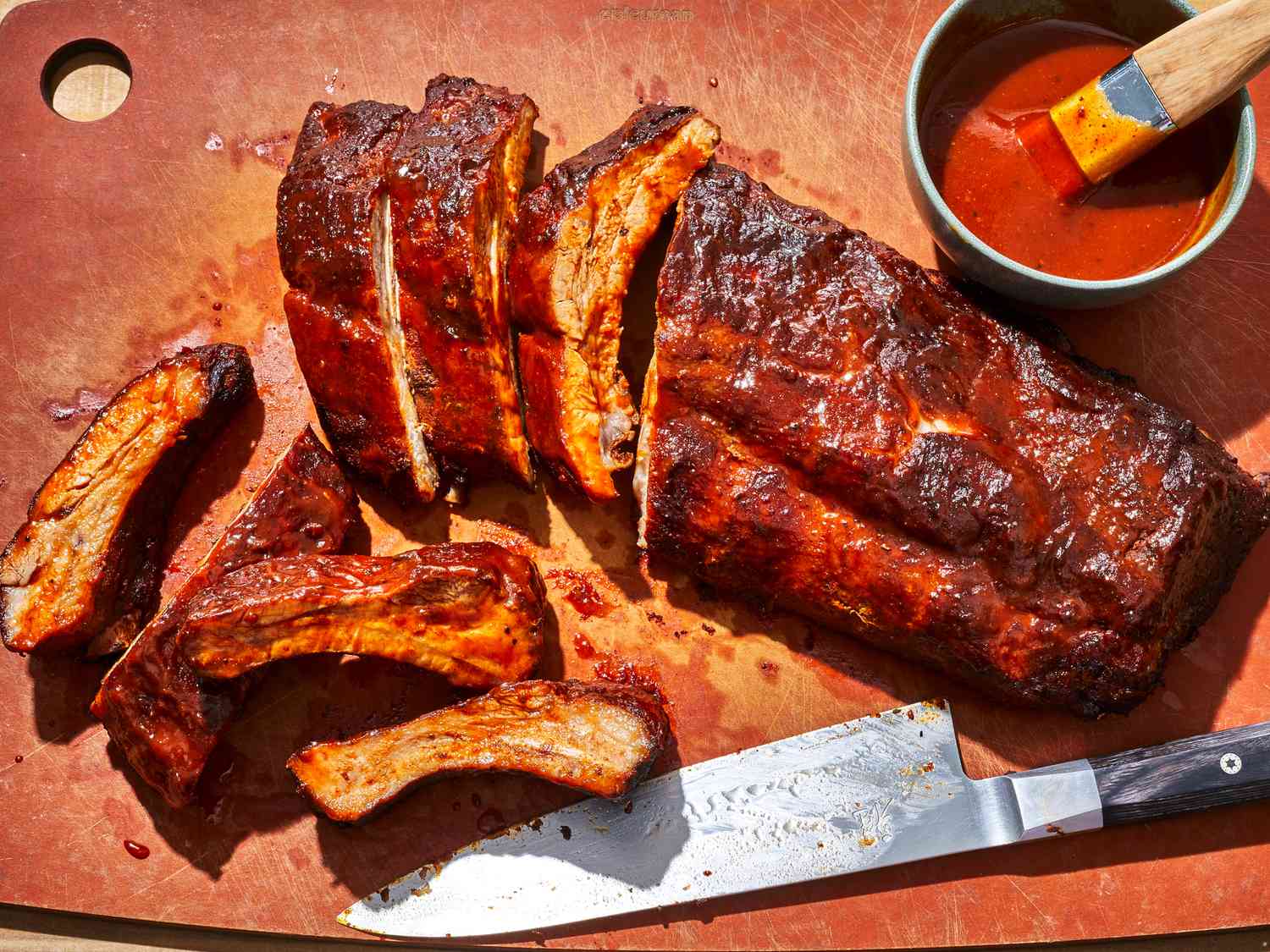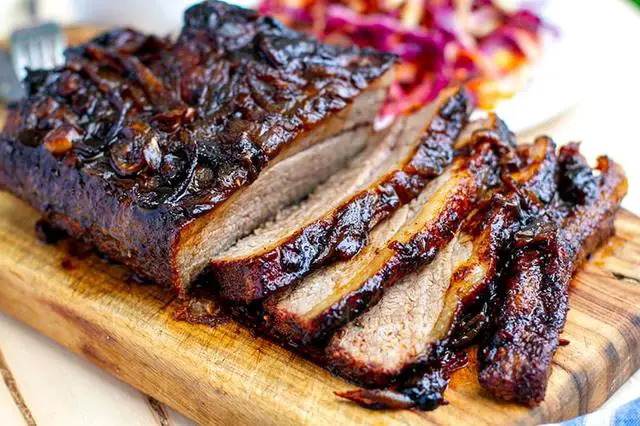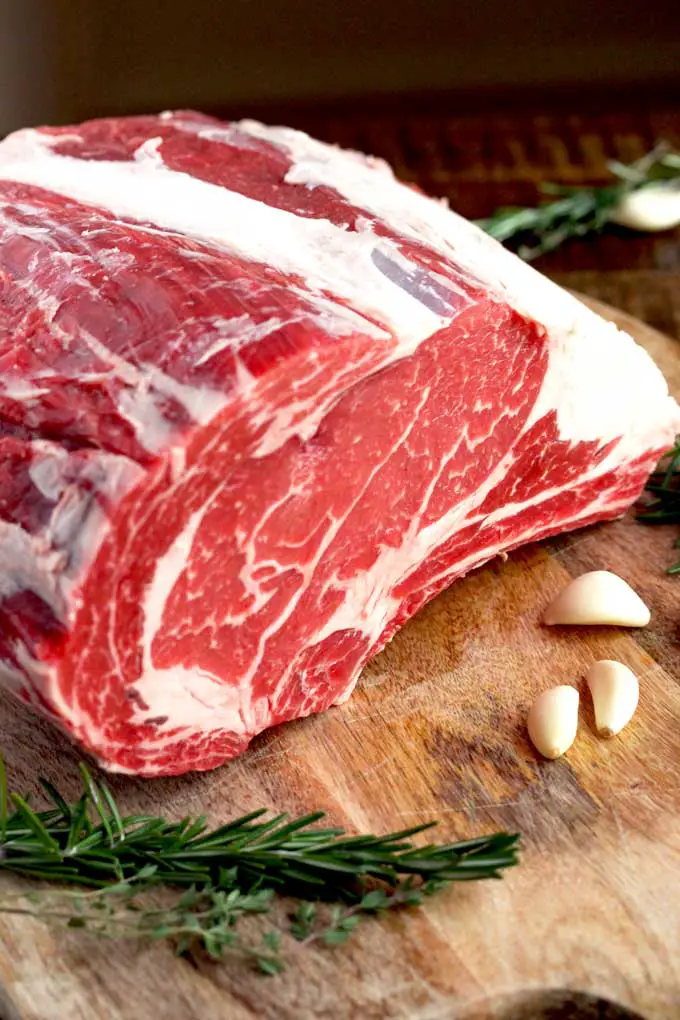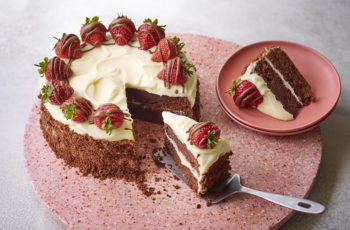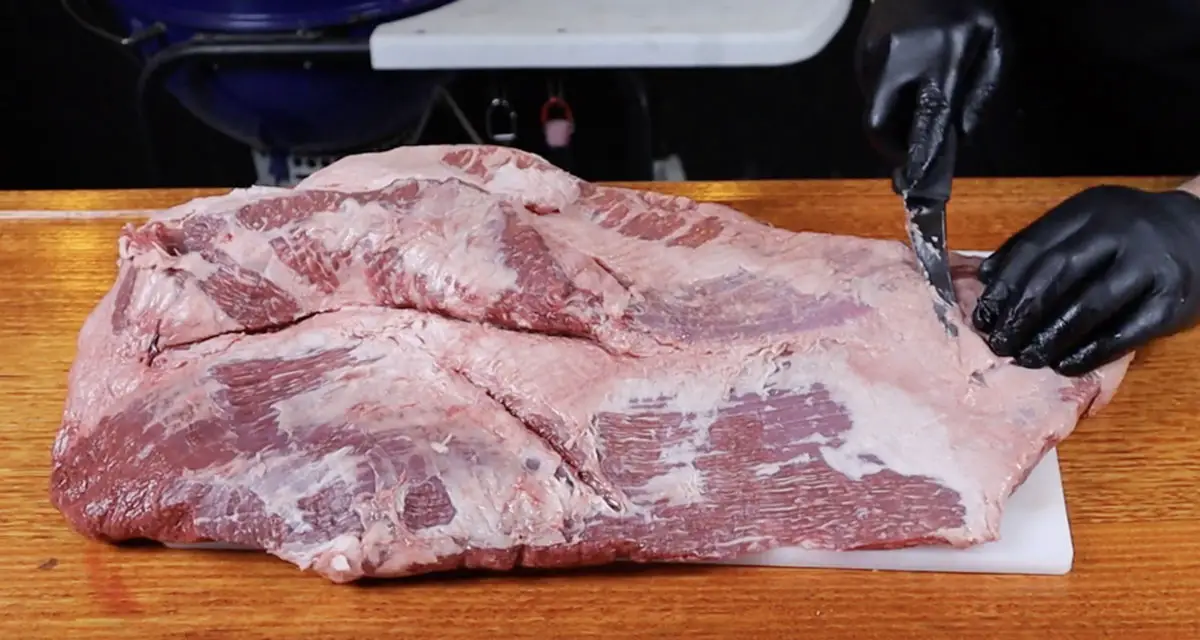
“Discover the Mouthwatering Delicacy of Brisket Deckle Fat: Unveiling the Richness and Flavor Hidden in Every Bite!”
How to Trim Brisket: A Complete Guide (with Pictures!)
Trimming brisket is an often overlooked but important step in the cooking process. While some may see trimming as wasteful, it can prevent dry or burned meat and allow for other uses such as tallow or burgers. This guide provides a detailed explanation of how to trim brisket, with accompanying pictures for reference.
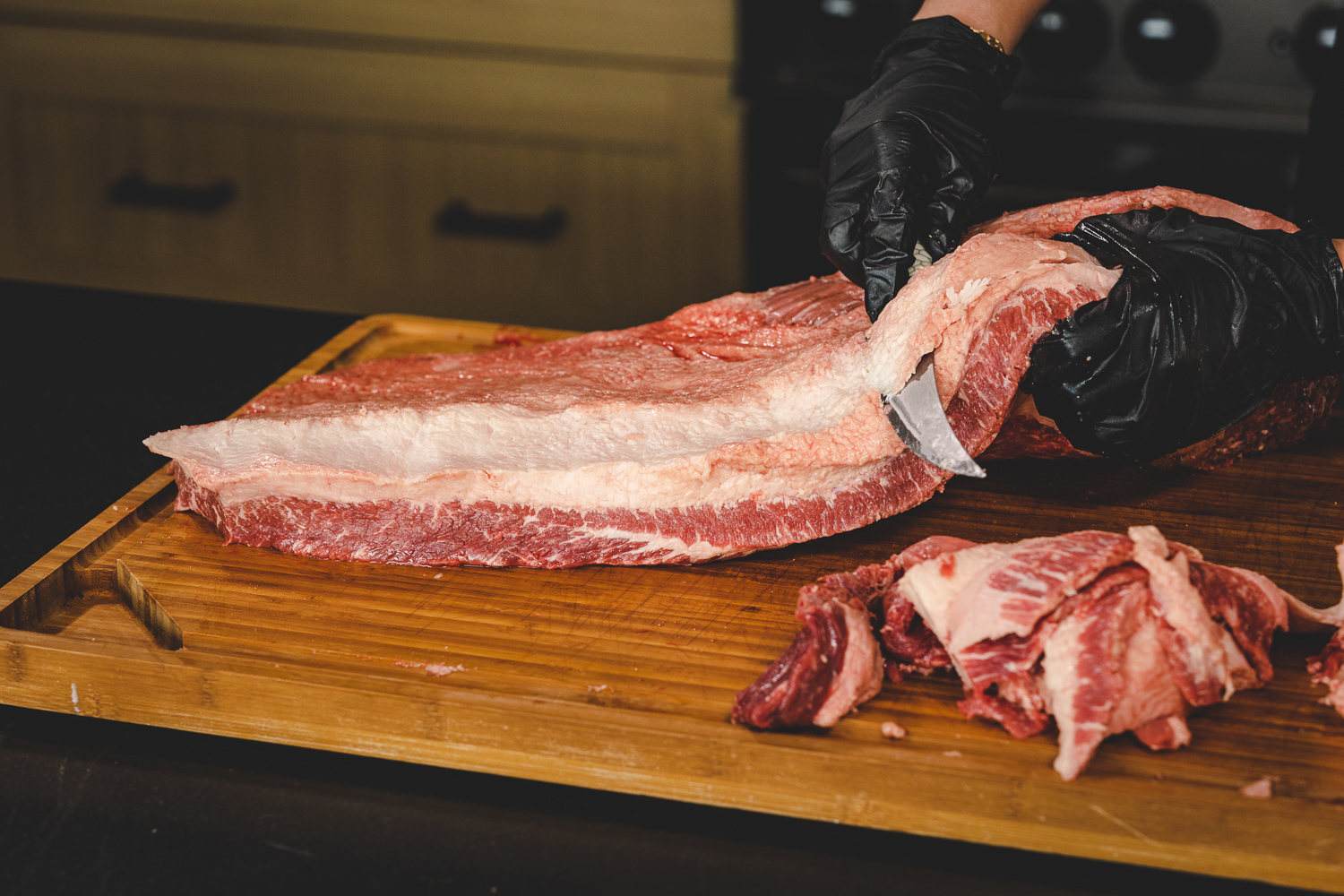
The goal of trimming brisket is to achieve aerodynamics and maximize the amount of edible meat. This involves working on both the fat side and the meat side of the brisket. The fat side includes sections such as the Mohawk, hump, slope, and fat cap thickness, while the meat side focuses on removing deckle fat and silver skin.
Before starting the trimming process, it is important to use a sharp knife. Investing in a boning knife is recommended for those who frequently smoke brisket. Popular knife brands include Victorinox and Mercer, with Mercer being more affordable.
It is personal preference which side to work on first, but starting with the fat side is recommended as it can be harder to work with when warm. Trimming the fat side involves removing sections like the Mohawk, rounding off edge meat, slicing hard fat at a 45-degree angle, and trimming down the hump.
The meat side of brisket is easier to trim compared to the fat side. Key areas to focus on are removing deckle fat by pulling it away from the brisket along its natural seam and removing larger nodules of fat and less transparent pieces of silver skin. Boxed edges should also be rounded to improve aerodynamics.
While some may view trimming as wasteful, it allows for a more even cooking process and improves the overall presentation and eating experience of the brisket. Trimmed pieces can be used for rendering into beef tallow or ground up for delicious brisket burgers.
Sections of the Brisket
The brisket primal is comprised of two muscles – the point and flat. These muscles are separated by a seam of fat. The point muscle is located closer to the front of the animal, while the flat muscle is towards the back. Understanding these sections is important for proper trimming.

On the fat side of the brisket, there are several sections that need attention during trimming. These include:
- Mohawk: A large scraggly piece of fat and meat that points upwards, resembling a mohawk haircut. It needs to be removed to prevent burning and can be used for brisket burgers.
- Hump: A chunk of fat that needs to be trimmed down to about 1/4 inch thickness.
- Slope: The area where the fat slopes down from the hump to the flat; a chunk of fat at this intersection needs to be removed.
- Flat Fat: The fat on top of the flat muscle, which should be trimmed to about 1/4 inch thickness for better aerodynamics.
On the meat side of the brisket, there are two main sections that require attention:
- Deckle Fat: A large piece of hard fat between the point and flat muscles that needs to be removed as it won’t render when smoked. It can be used for beef tallow.
- Silverskin: The thin layer on top of the fat meat that can be partially removed if desired, but not necessary for backyard barbecues.
The goal of trimming brisket is to make it more aerodynamic for even smoking, improve presentation and eating experience, and maximize the amount of edible meat. By removing excess fat and shaping the brisket, you can achieve better results in terms of flavor and tenderness.
How to Trim a Brisket for Backyard Barbecue
Trimming a brisket for backyard barbecue is an essential step to ensure a successful and flavorful cook. By removing excess fat and shaping the meat, you can improve aerodynamics, presentation, and maximize edible meat.
Start by focusing on the fat side of the brisket. Remove the Mohawk, which is a large scraggly piece of fat and meat that points upwards. This part will burn if left on during cooking but can be ground up for delicious brisket burgers. Next, trim down the hump of fat and aim for about 1/4 inch thickness. Round the edges of the flat fat to improve aerodynamics.
On the meat side, remove the deckle fat between the flat and point muscles. This hard fat will not render when cooked but can be used for rendering into beef tallow. Finally, remove any large nodules of fat or less transparent pieces of silver skin on top of the fat meat.

Which Side to Start On?
When it comes to trimming the brisket, it is entirely a personal preference as to which side you choose to work on first. Some people prefer to work on one side of the brisket at a time, while others may prefer flipping the brisket over. If you choose to work on one side at a time, like I do, I recommend starting with the fat side. This is because fat can be harder to work with as it warms up. By starting with the fat side, you can trim it while it’s still cold and easier to handle.
The fat side of the brisket is more important than the meat side in terms of trimming. Each brisket is different, with variations in fat cap thickness and other sections such as the Mohawk and hump. By tackling these areas on the fat side, you can significantly improve your brisket. The main things to focus on when trimming the fat side are removing the Mohawk (a large scraggly piece of fat and meat that points upwards), rounding off the point muscle, trimming down the hump of fat, and achieving a uniform thickness for the flat muscle.
The meat side of the brisket is relatively easier to trim compared to the fat side. There are two main areas to focus on – removing the deckle fat and addressing any silver skin on top of the fatty meat. The deckle fat is a large piece of meat that lies between the flat and point muscles. By pulling it away from the brisket along its natural seam, you can remove this hard fat that will not render when smoked. As for silver skin, some people choose to remove only larger nodules of fat and less transparent pieces while others may remove all of it. The choice is personal and may depend on presentation preferences.
The Fat Side
When trimming the brisket, it is important to pay attention to the fat side. This side consists of several sections that need to be addressed in order to improve the overall quality of the meat. These sections include the point muscle, the Mohawk, the hump, the slope, and the flat fat.
One important section on the fat side is the point muscle. This is a large scraggly piece of fat and meat that points upwards, resembling a Mohawk haircut. It is necessary to remove this part as it will burn and become inedible during cooking. However, it can also be used for ground beef or brisket burgers.
Another section on the fat side is the hump. This is a chunk of fat that needs to be trimmed down for better aerodynamics and even smoking. By shaving off about 1/4 inch of fat from this area, you can ensure a more uniform thickness in your brisket.
Adjacent to the hump fat is an intersection where the slope begins. This slope refers to the downward slant of fat from the brisket to the flat. It is important to remove any excess chunk of fat at this spot for better presentation and cooking results.
In addition to these sections, there is also flat fat that needs attention. This includes both edges and surface areas that may affect aerodynamics and cooking time. Trimming this part first can help determine where to end your slope cut and create a more rounded shape for better smoking results.
1. The Mohawk
The Mohawk refers to a large scraggly piece of fat and meat that points upwards on the brisket. It is important to remove this part as it will burn and become inedible when cooked. However, the Mohawk can also be used to make delicious brisket burgers by grinding up the meat. To remove the Mohawk, glide your knife through it and round off the point muscle.
Next to the Mohawk is a “hump” of fat that needs to be trimmed down. You can easily feel the top of the hump to identify the hard fat, which should be removed. Shave off approximately 1/4 inch of fat from the hump, making sure not to scalp the brisket too much. This fat trimming helps improve aerodynamics during smoking.
The flat fat refers to the portion of fat on one side of the flat muscle, which is usually thinner than the hump side. Slice this corner at a 45-degree angle to make it roughly uniform in thickness, aiming for around 1 inch thick. By cutting at an angle, you are naturally being more aerodynamic with your cuts.
1.1 Mohawk Edge
The Mohawk is a large scraggly piece of fat and meat that points upwards on the brisket. It resembles a Mohawk haircut and needs to be removed before cooking. If left on, the Mohawk will burn and become inedible. However, it can be ground up and used for brisket burgers.
Adjacent to the Mohawk, there is usually some edge meat that has been browned due to oxidation. While this meat doesn’t affect the taste, it is often removed for aesthetic purposes. It can also be saved and used for burgers.
After trimming the Mohawk and edge meat, there is usually a piece of hard fat that needs to be removed. This fat doesn’t render well and should be sliced off at a 45-degree angle.
Next to the Mohawk is a “hump” of fat that needs to be trimmed down. By feeling the top of the hump, you can distinguish between hard fat and renderable fat. The goal is to remove about 1/4 inch of fat from the hump.
On the flat side of the brisket, there may be boxy angles caused by excess fat. These angles are bad for aerodynamics in the smoker, so it’s recommended to round them out to improve airflow.
At the intersection where the hump fat meets the flat fat, there is often a chunk of fat that needs to be removed. By angling your knife, you can drop from the edge of the hump fat down to the level of the flat fat and remove this chunk.
By following these trimming steps, you can improve the aerodynamics of the brisket and maximize the amount of edible meat.
1.2 Mohawk Deckle
The Mohawk deckle is a large scraggly piece of fat and meat that points upwards on the brisket. It resembles a Mohawk haircut. This part needs to be removed as it will burn and become inedible during the cooking process. However, it can also be used to make delicious brisket burgers. To remove the Mohawk deckle, glide your knife through it and round off the point muscle.
Adjacent to the Mohawk deckle, there is usually some edge meat that needs to be removed. This meat is typically “browned” due to oxidation and does not affect the taste of the brisket. Remove this meat by slicing to the right of the Mohawk at a 45-degree angle.
Next to the Mohawk, there is a “hump” of fat that needs to be trimmed down. You can feel for the hard fat on top of the hump and start shaving off fat until you have roughly 1/4 inch remaining. Don’t worry if you accidentally scalp a small spot; even experienced trimmers make this mistake sometimes.
The flat fat cap is usually thicker on this side of the brisket compared to the Mohawk side. It may have boxy angles, which are not ideal for aerodynamics when smoking. Trim this fat so that it is roughly 1/4 inch thick, making peak cuts along the way to avoid scalping issues.
The meat side of the brisket is easier to trim than the fat side. There are two main areas to focus on: removing the deckle fat and trimming any silver skin on top of the fat meat.
The deckle fat is a large piece of meat that lies on the fat seam between the flat and point muscles. Physically pull the deckle fat away from the brisket, following its natural seam. Use the tip of your knife to make a slight cut and start pulling it back towards you. Remove enough fat until you can see the lean meat of the point muscle, but be careful not to entirely remove all the fat.
The silver skin on top of the fat meat can be removed selectively. Remove larger nodules of fat and any less transparent pieces of silver skin. It’s not necessary to remove every bit of silver skin, especially if it doesn’t affect your presentation side when smoking.
The goal of trimming brisket is to maximize edible meat while improving presentation and cooking experience. By removing excess fat and trimming boxy edges, you create a more aerodynamic brisket that cooks evenly. The trimmed portions can be used for beef tallow or ground up to make delicious brisket burgers.
1.3 Mohawk Flat
The Mohawk flat refers to the area of the brisket that includes the scraggly piece of fat and meat that points upwards, resembling a Mohawk haircut. This part of the brisket needs to be removed as it will burn and become inedible. However, the meat from the Mohawk can be ground up and used for brisket burgers. To trim the Mohawk flat, glide your knife through the Mohawk and then round off the point muscle.
Adjacent to the Mohawk, there is often edge meat that is typically “browned” due to oxidation. While this meat doesn’t affect taste, it can be removed for a cleaner trim. Use your knife to slice off this edge meat by cutting to the right of the Mohawk at a 45-degree angle.
Next to the Mohawk is a “hump” of fat that needs to be trimmed down. The hard fat on top of the hump will feel different from renderable fat, which will almost feel and look like cottage or ricotta cheese. Using your knife, shave off roughly 1/4 inch of fat from the hump to achieve a more desirable thickness.
The flat fat cap on one side of the brisket may be thicker than on other sides. To create a more uniform thickness in the flat, slice this corner at a 45-degree angle so that it is roughly an inch thick.
On every brisket, there is a spot where the point muscle meets the flat muscle and fat slopes down from the brisket to the flat. Trim away any chunk of fat at this intersection by angling your knife to drop from the edge of the hump fat down to the level of the flat fat. Remove the slope fat with your knife.
On the meat side of the brisket, there are two areas that need attention – the deckle fat and the silverskin on top of the fat meat.
The deckle fat is a large piece of meat that lays on the fat seam between the flat and point muscles. Using your hands, physically pull away the deckle fat from the brisket, feeling for a natural seam where it tears away. Use your knife to make a slight cut at an angle and start pulling back towards you until you can visually see the lean meat of the point muscle.
The silverskin on top of the fat meat can be removed by cutting away large nodules of fat and less transparent pieces of silver-skin. While some may prefer to remove all silver-skin, leaving some on does not significantly affect taste or cooking results.
By following these trimming guidelines, you will create a more aerodynamic brisket that cooks evenly and maximizes edible meat. Trimming away excess fat and removing inedible parts not only improves presentation but also enhances the overall eating experience. The trimmed portions can be used for making beef tallow or ground up for delicious brisket burgers.
2. The Hump
The hump refers to a section of fat on the fat side of the brisket that needs to be trimmed down. It can easily be identified by feeling for the hard fat on top of the hump. This hard fat should be shaved off, leaving about 1/4 inch of fat remaining. The softer, renderable fat will feel and look like cottage or ricotta cheese. Care should be taken not to scalp the brisket while trimming this section, as it is easy to accidentally remove too much meat. To avoid this, you can make “peak cuts” into the meat to gauge how much fat separates the lean meat.
The slope refers to a chunk of fat at the intersection where the point muscle meets the flat muscle on the other side of the hump fat. To trim this section, angle your knife from the edge of the hump fat down to the level of the flat fat and then dig out the slope fat with your knife. Removing this chunk of fat helps improve aerodynamics and ensures even cooking throughout the brisket.
The deckle fat is a large piece of meat that lays on the seam between the flat and point muscles on the meat side of the brisket. It can be removed by physically pulling it away from the brisket, following its natural seam. Using a knife at an angle, make a slight cut and start pulling it back towards you until you hear it tearing away from the brisket. Removing most but not all of this fat allows for better separation between muscles while still retaining some flavor and moisture.
Silverskin refers to a thin layer of connective tissue that covers some parts of the fatty meat on top of the brisket. While some prefer to remove all of the silverskin, it is not necessary for backyard barbecue and can be time-consuming. Instead, focus on removing large nodules of fat and less transparent pieces of silverskin that may affect the texture or appearance of the cooked brisket.
Boxy or square edges on the brisket can result in poor aerodynamics during cooking, with these areas finishing faster than the rest of the meat. To improve aerodynamics and ensure even cooking, trim any boxy edges from the brisket. This will help maintain consistent temperatures throughout the meat and enhance presentation.
By following these trimming techniques, you can make your brisket more aerodynamic, improve presentation and eating experience, and maximize edible meat.
2.1 Hump Edge
On the fat side of the brisket, there is a section called the hump edge. This refers to the area where the hump of fat meets the flat muscle. It is important to trim this section properly to ensure even cooking and improve the overall presentation and eating experience of the brisket. Using a sharp knife, you can angle it from the edge of the hump fat down to the level of the flat fat and remove any excess chunk of fat that sits in this intersection.
Another important section on the fat side of the brisket is called the Mohawk. This refers to a large scraggly piece of fat and meat that points upwards, giving the brisket an appearance similar to a Mohawk haircut. It is crucial to remove this part as it will burn and become inedible during cooking. However, it can be used for ground brisket burgers if desired. Glide your knife through the Mohawk and round off the point muscle.
The slope fat is located on the other side of the hump fat, where it slopes down from the brisket to meet with the flat muscle. It is necessary to trim this section by angling your knife and removing any excess chunk of fat that sits here. Trimming this slope fat helps improve aerodynamics during smoking and ensures even cooking throughout.
On top of the flat muscle, there is a layer of fat known as flat fat. It is recommended to trim this section first before determining where to end your slope fat cut. The goal is usually a 1/4 – 1/2 inch thick flat cap, but personal preference may vary. Making peak cuts can help gauge how much fat separates lean meat and avoid scalping issues.
Moving to the meat side of the brisket, there is a section called the deckle fat. This refers to a large piece of meat that lays on the fat seam between the flat and the point muscles. It is important to remove this deckle fat as it is hard fat that will not render when smoked. However, it can be used for rendering into beef tallow. By pulling it away from the brisket and making slight cuts with a knife, you can remove the deckle fat and expose the lean meat of the point muscle.
The silverskin is a thin layer of connective tissue that covers the fat meat on top of the brisket. While some trimmers prefer to remove all silver skin, others only remove larger nodules of fat and less transparent pieces. The decision to remove or leave silver skin may depend on personal preference and cooking methods.
Boxed edges refer to square or non-rounded edges on the brisket, which can result in poor aerodynamics during smoking. These areas may finish faster than other parts of the brisket. Trimming these boxed edges can help improve airflow and ensure even cooking throughout.
By properly trimming these sections of the brisket, you can enhance its overall appearance, taste, and cooking experience while maximizing edible meat for delicious meals.
2.2 Hump Flat
The hump flat is a section of the brisket that is usually thicker than the mohawk flat but has a boxy shape. This boxy angle is not ideal for aerodynamics during smoking, especially if you have a smaller smoker. Trimming the hump flat allows you to make the brisket smaller and more uniform in thickness. The goal is to round off this section so that it fits better in your smoker and cooks evenly. Most recommendations suggest having a 1/4 to 1/2 inch thick fat cap in the flat, but it ultimately depends on personal preference. By trimming the hump flat first, you can determine where to end your slope fat cut on the other side of the brisket.
3. Flat Fat
The flat fat refers to the layer of fat that covers the flat muscle on the brisket. It is important to trim this fat to ensure even cooking and to improve the overall presentation and eating experience of the brisket. When trimming the flat fat, aim for a thickness of around 1/4 inch. This will help render the fat properly during smoking and prevent any excessive charring or burning.
To trim the flat fat, make angled cuts towards the edge rather than surface cutting. This will create a more aerodynamic shape and help the brisket cook more evenly. Use peak cuts to check the thickness of the fat and make adjustments as needed. Remember, a uniform thickness of around 1/4 inch is ideal for optimal results.
4. The Slope Fat
The slope fat refers to the chunk of fat that sits at the intersection where the point muscle meets the flat muscle on the other side of the hump fat. This fat slopes down from the brisket to the flat. To trim this section, you will need to angle your knife and drop from the edge of the hump fat down to the level of the flat fat. From there, you can use your knife to dig out and remove the slope fat.
Trimming this slope fat is important for a few reasons. Firstly, it helps improve aerodynamics during smoking, ensuring that all parts of the brisket cook evenly. Additionally, removing this chunk of fat can help improve presentation and create a better eating experience. Finally, trimming the slope fat allows you to maximize edible meat by removing excess fat in this area.
By following these trimming steps, you’ll be able to achieve a well-trimmed brisket that is ready for smoking or cooking. Remember that personal preferences may vary when it comes to trimming, so feel free to adjust these steps based on your own preferences and cooking style.
Meat Side
The meat side of the brisket is much easier to trim compared to the fat side. There are two main areas to focus on – the deckle fat and the silverskin on top of the fat meat.
The deckle fat is a large piece of meat that lies on the fat seam between the flat and the point muscles. By using your hands, you can physically pull the deckle fat away from the brisket, feeling and hearing it tear along its natural seam. Using the tip of your knife at an angle, make a slight cut and start pulling it back towards you. Continue removing chunks of deckle fat until you can visually see the lean meat of the point muscle.
The silverskin is a thin layer of connective tissue that covers some parts of the brisket. While some people prefer to remove all traces of silverskin, it’s not necessary for backyard barbecue cooking. Simply remove any large nodules of fat or less transparent pieces of silverskin. You don’t need to spend excessive time meticulously removing every bit of silverskin, as its impact on flavor and cooking is minimal.
1. The Deckle Fat
Trimming the deckle fat is an important step in preparing a brisket. The deckle fat is a large piece of meat that lies between the flat and the point muscles. To remove it, start by pulling it away from the brisket, feeling for the natural seam where it tears away. Then, use the tip of your knife at an angle to make a slight cut and begin pulling it back towards you. Continue removing the deckle fat until you can visually see the lean meat of the point muscle.
Next, focus on removing any silver skin on top of the fat meat. While some people prefer to remove all silver skin, it is not necessary to remove every bit of it. Instead, focus on removing larger nodules of fat and less transparent pieces of silver skin. This step helps improve the overall appearance and texture of the brisket.
Boxy or square edges on a brisket can lead to uneven cooking and faster finishing times for certain parts of the meat. To ensure even cooking, trim any boxy edges so that they are more rounded. This will help improve aerodynamics in your smoker and result in a better overall eating experience.
By following these trimming steps, you can maximize edible meat, improve presentation, and create a more enjoyable brisket cooking experience.
2. Fat Nodules and Silver Skin
When trimming the brisket, it’s important to pay attention to any fat nodules and silver skin that may be present. Fat nodules are small pockets of fat that can be found in various parts of the brisket. It’s best to remove these nodules as they will not render well during cooking and can result in unevenly cooked meat. Additionally, silver skin refers to the tough connective tissue that covers some parts of the brisket. While some prefer to remove all silver skin, others may choose to only remove larger pieces or those that are less transparent. The decision on how much silver skin to remove is largely a matter of personal preference.
One aspect of trimming the brisket that is often overlooked is ensuring that the edges are rounded rather than square or boxy. Boxed edges can lead to poor aerodynamics during cooking and may cause certain parts of the brisket to cook faster than others. To avoid this issue, it’s recommended to trim any square or boxy edges so that all parts of the brisket cook evenly. While spritzing the meat during cooking can help salvage boxed edges, it’s generally easier and more effective to trim them from the start.
After completing the trimming process, there should be a noticeable difference in the appearance of the brisket. The goal is to make the brisket more aerodynamic, improve its presentation, enhance the eating experience, and maximize edible meat. By removing excess fat, trimming fat nodules and silver skin, and rounding any boxed edges, you’ll have a trimmed brisket ready for cooking. It’s worth noting that some people may consider this trimming process wasteful due to discarding certain parts of the brisket. However, these trimmings can be saved and used for other purposes such as rendering into beef tallow or grinding up for brisket burgers.
3. Boxy Edges
Boxy edges on a brisket can result in poor aerodynamics in the smoker. These non-rounded edges can cause the meat to finish cooking faster than the rest of the brisket, leading to uneven results. While you can spritz the meat to salvage these spots, it is often easier and more effective to trim them from the beginning. By removing these boxy edges, you can improve the overall cooking experience and ensure that all parts of the brisket are smoked evenly.
Brisket Trim Before and After
When it comes to trimming a brisket, the before and after pictures can be quite remarkable. Before trimming, a brisket may have excess fat, uneven edges, and sections that can affect the cooking process. However, after a proper trim, the brisket becomes more aerodynamic, with all parts being evenly smoked.
The trim focuses on various sections of the brisket’s fat side, including the point muscle, the Mohawk (a scraggly piece of fat and meat), the hump (a chunk of fat), the slope (where the point muscle meets the flat muscle), and flat fat. By removing excess fat and shaping the brisket to be more uniform in thickness, it not only improves presentation but also enhances the eating experience. Additionally, trimming maximizes edible meat by removing parts that won’t render well when smoked.
After a successful trim, the difference in appearance is evident. The brisket looks cleaner and more streamlined, ready to be cooked to perfection. The trimmed pieces can also be repurposed for other dishes like beef tallow or ground up for delicious brisket burgers.
What to Do with Brisket Trimmings?
When it comes to the trimmings from your brisket, there are a few options for what you can do with them. One option is to freeze the trimmings and save them for later use. You can use the trimmings to make tallow, which is a great cooking fat that can be used in various recipes. The hard fat from the deckle and other trimmings works well for rendering into tallow.
Another option is to grind up the trimmings and use them to make brisket burgers. The meat from the trimmings can be ground up and seasoned to create flavorful burgers that are sure to impress. This is a great way to make use of every part of the brisket and minimize waste.
No matter what you choose to do with your brisket trimmings, it’s important to remember that they can still be valuable and delicious. Don’t overlook this often disregarded part of the process, as it can provide you with tasty options for future meals.
In conclusion, brisket deckle fat adds a rich and flavorful element to dishes. While it may be higher in calories, it enhances the taste and texture of the meat. Moderation is key when consuming this indulgent cut of beef, but when used wisely, it can elevate any dish to new levels of deliciousness.
Learn More About Grilling
If you want to learn more about grilling, check out these other helpful resources!


